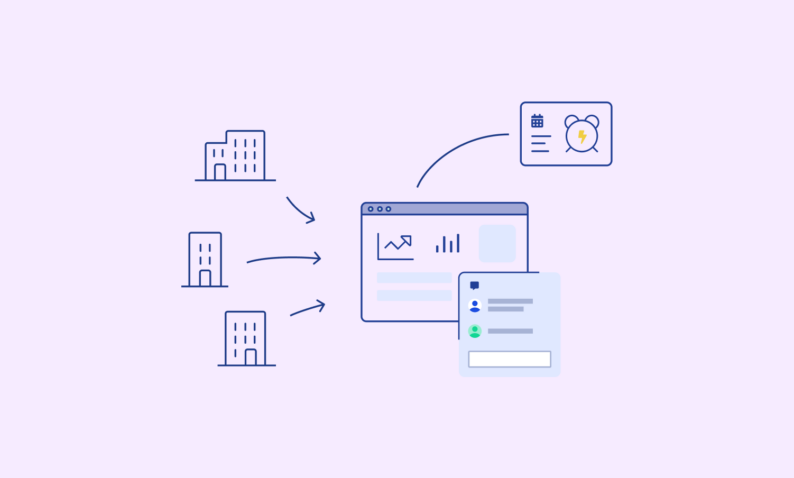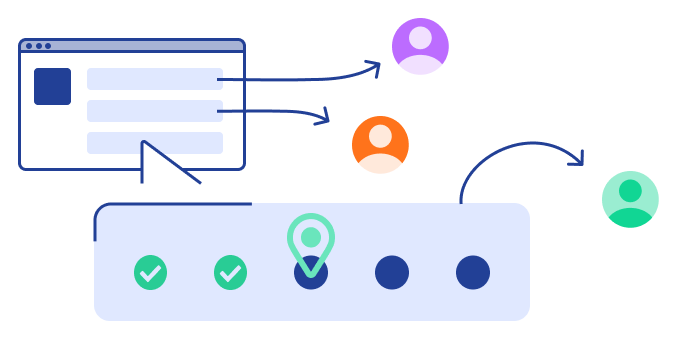
Get Started
Graphite's supplier management tool helps you onboard faster, cut time on risk reviews and streamline supplier validations. Save time and money.
December 12 2022
Running an Efficient Supplier Onboarding Program
How to create more streamlined processes in procurement.
Want to take your procurement team to the next level? While that’s a great intention, the first step in that process may seem counterintuitive.
Take a look at how your team members are spending their time. Is your supplier intake process clear, simple, and easy to follow? Are you wasting time on unnecessary steps? If you aren’t happy with your answers, it may be time to revamp your procurement processes.
Whether your team is one person or twenty, when you meet your company’s basic business needs efficiently and effectively, you can expand your procurement function to do much more.
Six Steps to Increase the Efficiency of Your Procurement Team:
Not sure how to meet those basic needs? These six steps are an excellent place to start.
1. Know the maturity of your business
The first step in running an efficient and valued procurement operation and successful supplier onboarding process is knowing where your business stands on the maturity scale. The needs of a new business can look quite different from those of a more mature business, and your team needs to mirror that maturity.
For example, the image below shows the stages of risk assessment and management. Depending on the size and maturity of your team, you may need to focus solely on defining and measuring risk. If you have a more robust team with clearly defined goals, you may be able to manage and monitor risk as well.

What you decide to focus on and how you build your foundation may depend on your business’s specific needs and goals. Your procurement team will shine if you can effectively meet current needs and drive your business closer to its goals.
Once you understand your organization’s goals better, you can structure your team accordingly. Ensure that your team executes primary procurement responsibilities, such as a robust supplier onboarding process, then place the extra resources into tasks to help your business accomplish its needs and goals.
Soon, your business will discover that it couldn’t function without you. With that kind of reputation, your spend under management will soar.
2. Create a centralized onboarding process
Is your onboarding process a bit of a mess right now? Low visibility and unclear procedures can slow down your team and decrease your value in the eyes of your fellow employees. If you want procurement to be synonymous with efficiency and helpfulness, this is something that you need to change.
Creating a centralized onboarding process will eliminate confusion and enhance stakeholder visibility every step of the way. Utilizing a procurement software tool like Graphite can significantly enhance the efficiency of your supplier onboarding program.
Graphite allows you to establish and maintain a list of preferred suppliers, centralizing the entire supplier management process. This centralized approach streamlines communication, simplifies decision-making, and provides easy access to key supplier information.
As a result, the onboarding process becomes quicker and more organized, reducing the time and effort required to integrate new suppliers into your business operations. By leveraging Graphite, procurement can focus on strategic activities rather than administrative tasks, thus optimizing the overall efficiency of your supplier onboarding program.
When you centralize your supplier intake and evaluation process, you enable requesters to get what they need faster with fewer clicks–reducing the number of requests your team has to manage. And when your team is freed to tackle higher-value negotiations and projects, you’ll bring more significant savings and value to your company.

3. Enhance visibility with supplier data management
Does your team have a centralized location, such as a supplier portal, for storing the most up-to-date supplier data? Too often, the answer is no. Instead, this data lives on individual computers and circulates among team members, complicating visibility and maintaining up-to-date information. Whatever your tool, your team will work more efficiently and accurately if your data and documents have a centralized home.
Also essential to think about is how your suppliers are providing you with data. Is the process quick and easy? Or is it different for each supplier? Creating streamlined processes for how suppliers give you data will increase your team’s efficiency and productivity.
With simplified internal processes, vetting the provided data quickly is much easier. The accuracy of different aspects of data can be assessed at each stage of your supplier onboarding program. And, when you have a central place to securely store that data, using and expanding your preferred supplier lists becomes even easier.
4. Be the gatekeeper for your company
Risk management is a hot topic in procurement, especially for large companies. However, procurement teams of any size should see themselves as the risk gatekeepers for their company. Any suppliers your team takes on bring risks to your company. And your company looks to your procurement team to mitigate those risks.
If you don’t have a set strategy for mitigating risk, you open your doors to the potential for costly mistakes. Categorize which supplier types have the greatest potential to expose your company to risk (for instance, a software company has a higher risk likelihood than a window washing company), and create a process for evaluating that risk.
Assess the most significant areas of risk for your company. Each company will be different. It’s your job to understand the risks associated with your suppliers and protect your company from danger. Consider each of the following in your risk assessment to create an effective action plan.
Financial risk
Financial risk can take many forms. Still, in this category, you should be looking out for the risk that a company will not be able to keep its end of the contract (for example, a reputable off-shore rubber supplier may not deliver the rubber you pay them for).
You should also be aware of any risk to your company’s financial information (e.g. Are your supplier portal and other relevant systems adequately protected if they receive customer data from your company?). Assess any possible risk that could result in a financial loss to you or your customers.
Also, be careful when assessing whether a company has not provided you with fraudulent financial information. Always vet their source-to-pay tool and ensure that it’s reputable and accurate. Otherwise, your company may risk losing money.
Cybersecurity risk
Never underestimate the seriousness of cybersecurity, especially in the digital age. In fact, cybersecurity represents one of the greatest risks to you and your company. During supplier onboarding and other internal processes, procurement must act as a gatekeeper to protect your company from cybersecurity risks.
If a supplier has access to your databases or any information about your business or customers, their cybersecurity risk must be thoroughly evaluated.
Compliance
Compliance is another critical area where procurement must ensure protection. Working closely with legal, you must be able to assess and address the risks associated with your company’s business practices, particularly in terms of complying with your country’s laws.
Whether financial, like a bank that must comply with specific financial laws, or physical, such as a construction company that must comply with stormwater drainage laws, compliance is a significant risk factor to consider during supplier onboarding. Do those suppliers have adequate systems in place to comply with the laws? If not, they will not be a good partner for your company.
Supply chain risk
As mentioned above, there is always the risk of a partner company not delivering. When vetting prospective suppliers for a business, it’s essential to understand its supply chain. Are there systems in place that will ensure their contract is upheld? Do they work with suppliers, and if so, do they properly vet their suppliers?
It’s important to remember that the risks to your business can extend beyond what you may think to assess. Be sure to analyze the whole supply chain and ensure your company will be protected at every step.
Social risks
A major up-and-coming factor in risk management is social risk. There are many different factors to social risk, including political, environmental, ethical, and diversity issues. Many businesses are seeking to improve their awareness of and impact on these risk factors.
Procurement must follow the organization’s goals regarding these risk factors. Because procurement is on the front lines when it comes to suppliers, it’s essential that your team understands how suppliers fit into these social risk categories and how your company can best meet its social goals.
Build a foundation where your team is trained to have a keen eye and a specific process for evaluating supplier risk. Ensure each team member understands best practices to mitigate and manage that risk. When you have strategies that consider each risk factor, this process will become much easier and more efficient.
5. Meet employees where they are
The last thing you want is for employees to see procurement as just another hurdle to jump before they can get something done. Procurement should be an aid and a facilitator for employees to speed up the tasks they have to complete.
Yet, too often, procurement systems get bogged down by too many unclear steps, whether in the supplier onboarding process or the evaluation and approval process. This can make it difficult for employees to maintain visibility into the program or understand why they must take certain steps.
Additionally, procurement creates more work for itself when constantly taking on new suppliers rather than utilizing current or approved suppliers.
But all that can change if you meet employees where they are. Procurement must be the one to reach out to employees, to help them understand where to begin the supplier onboarding process and how to maintain visibility throughout these new supplier relationships.

If you’ve successfully centralized your vendor onboarding process, as we suggest in step two, meeting employees where they are (rather than expecting them to come to you) will be an easy and advantageous next step.
6. Advertise your team internally
Even with the best intentions to meet employees where they are, if they don’t even know you exist, you’ll find they still don’t use the onboarding processes you’ve put right in front of them. For most of the company, their focus is outward. Selling products to businesses or consumers outside the organization. Your job in procurement is to sell yourselves internally.
Advertising your procurement team will not happen organically or automatically. You’ll have to create internal marketing campaigns to ensure that every employee at the business knows who you are, what you stand for, and how they can use your services to speed up their work.
With the right messaging (combined with the right centralized processes), you’ll find that procurement becomes a department that is no longer viewed in a negative light. Instead, procurement will become a department that employees don’t know what they’d do without.
Become the Team Your Business Can’t Live Without
If you’re looking for a complete solution to centralize your supplier onboarding process, manage all the necessary data, and increase stakeholder visibility-– Graphite is the solution for you.
Request a Demo